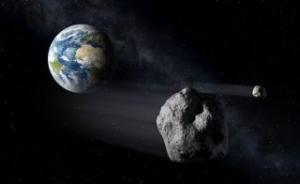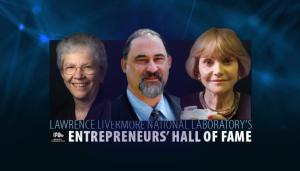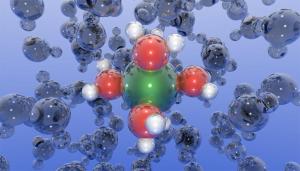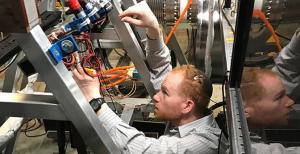LAB REPORT
Science and Technology Making Headlines
April 1, 2022


To determine how much the global water cycle has intensified, climate scientists turn to the oceans, where most of Earth’s evaporation and precipitation occurs and measure the changes in salinity.
Dry getting drier, wet getting wetter
Human-induced climate change is warming the planet and, in turn, enabling our atmosphere to hold more moisture. The magnitude and extent of this shift are challenging to see on a global scale, but its effects on local weather are much more noticeable: Greater evaporation in some regions and increased precipitation in others has already driven more frequent and intense droughts and rainfall — with the risk of more extreme weather events looming in the near future.
“In recent years, we have continued to experience unprecedented floods where huge amounts of water have flushed through the climate system,” says Paul Durack, a climate scientist at the Lawrence Livermore National Laboratory. “Such changed conditions are consistent with the warming atmosphere and a turbo-charged water cycle.”
But determining how much the global water cycle has intensified isn’t easy. Evaporation rates are difficult to measure and, barring covering the entire globe with rain gauges, the estimation of precipitation levels is just as challenging. To work around this, climate scientists turn to the oceans, where most of Earth’s evaporation and precipitation occurs and measure the changes in salinity.

An artist's depiction of asteroids passing near Earth. Image courtesy of NASA.
A-rock-alypse now
Scientists are studying how nuclear weapons could divert or annihilate threatening space rocks heading toward Earth. And later this year, the Double Asteroid Redirection Test, a NASA space mission, will slam into an asteroid in an attempt to change its orbit around the sun — a dry run for the day when we need to knock an asteroid out of Earth’s way for real.
Although scientists suspect that most near-Earth asteroids big enough to cause worldwide devastation have been identified, a handful may still be hiding behind the sun.
More concerning are near-Earth asteroids about 460 feet across, which number in the tens of thousands. They can create city-flattening blasts “larger than any nuclear test that’s ever been conducted,” said Megan Bruck Syal, a planetary defense researcher at the Lawrence Livermore National Laboratory. And astronomers estimate that they have currently found about half of them.
Even an asteroid just 160 feet across hitting Earth is “still a really bad day,” Bruck Syal said. One such rock exploded over Siberia in 1908, flattening 800 square miles of forest. “That’s still 1,000 times more energy than the Hiroshima explosion.” And perhaps only 9% of near-Earth objects in this size range have been spotted.


One current and two former Lawrence Livermore National Laboratory scientists have been inducted into the Laboratory’s Entrepreneurs’ Hall of Fame. From left: Mary Spaeth, Tony Ruggiero and Natalia Zaitseva.
Claim to fame
One current and two former Lawrence Livermore National Laboratory (LLNL) scientists have been inducted into the Laboratory’s Entrepreneurs’ Hall of Fame (EHF).
The trio, who represent the third class of inductees into the Lab’s EHF, have been honored for developing technologies during or after their Lab careers that created major economic impacts or spawned new companies.
Tony Ruggiero joined the LLNL Physics directorate in 1990 and his career evolved over the next 18 years, highlighted by significant research and development advances in ultrahigh bandwidth laser optical free-space communications.
Laser physicist Mary Spaeth joined the LLNL Laser Program in 1974, attracted to Livermore by the opportunity to use tunable dye lasers to produce enriched uranium, a technology later transferred to the U.S. Enrichment Corporation for further commercial development.
Materials scientist Natalia Zaitseva joined LLNL in 1993 to lead the development of rapid growth technology for large potassium dihydrogen phosphate and potassium dideuterium phosphate crystals for the National Ignition Facility, a technology that proved critical for the laser’s eventual success.


Water molecules (shown with red oxygen atoms and white hydrogen atoms) form complex dynamic structures around dissolved metal ions (shown in green). The ease with which these structures can form or break apart often controls the rate at which metals corrode. Image by Stephen Weitzner/LLNL.
Eating away at corrosion rates
Most metal alloys are prone to corrosion, which costs hundreds of billions of dollars of damage annually in the U.S. alone. Accurately predicting corrosion rates is a long-standing goal of corrosion science, but these rates depend strongly on the specific operating environment.
At the atomic scale, these environmental factors are associated with how quickly and easily metal ions dissolve and transport across solid-liquid interfaces.
With that in mind, scientists at Lawrence Livermore recently used molecular dynamics simulations to unveil and describe the dynamical behavior of dissolved metal ions and water — a key component of this corrosion puzzle.
They introduced a new methodology to describe the strength and nature of chemical bonding between rapidly moving ions in solution. These ions are surrounded by closely held water molecules in the so-called hydration shell, which fluctuates dynamically in ways that can be analyzed computationally.


LLNL physicist James Mitrani sets up scintillator detectors to measure neutrons on the University of Washington’s Fusion Z-Pinch Experiment (FuZE) device.
In a pinch
In findings that could help advance another “viable pathway” to fusion energy, research led by Lawrence Livermore National Laboratory (LLNL) physicists has proven the existence of neutrons produced through thermonuclear reactions from a sheared-flow stabilized Z-pinch device.
The researchers used advanced computer modeling techniques and diagnostic measurement devices honed at the Lab to solve a decades-old problem of distinguishing neutrons produced by thermonuclear reactions from ones produced by ion beam-driven instabilities for plasmas in the magneto-inertial fusion regime.
While the team’s previous research showed neutrons measured from sheared-flow stabilized Z-pinch devices were “consistent with thermonuclear production, we hadn’t completely proven it yet,” said LLNL physicist Drew Higginson.
“This is direct proof that thermonuclear fusion produces these neutrons and not ions driven by beam instabilities,” said Higginson, principal investigator of the Portable and Adaptable Neutron Diagnostics team that is doing research under a Department of Energy Advanced Research Projects Agency-Energy cooperative agreement. “It’s not proven they’re going to get energy gain, but it is a promising result that suggests they are on a favorable path.”





